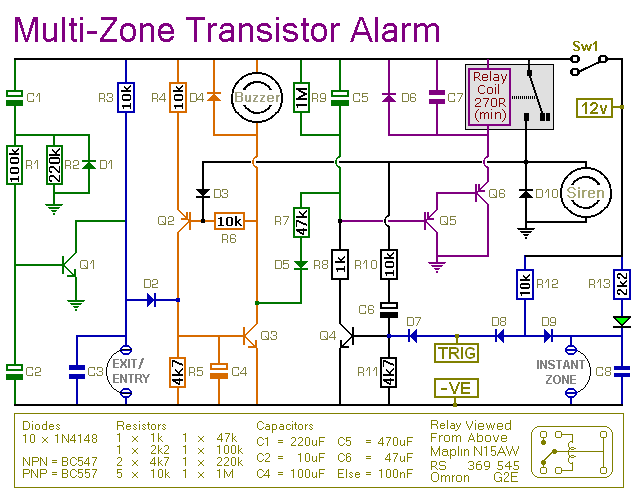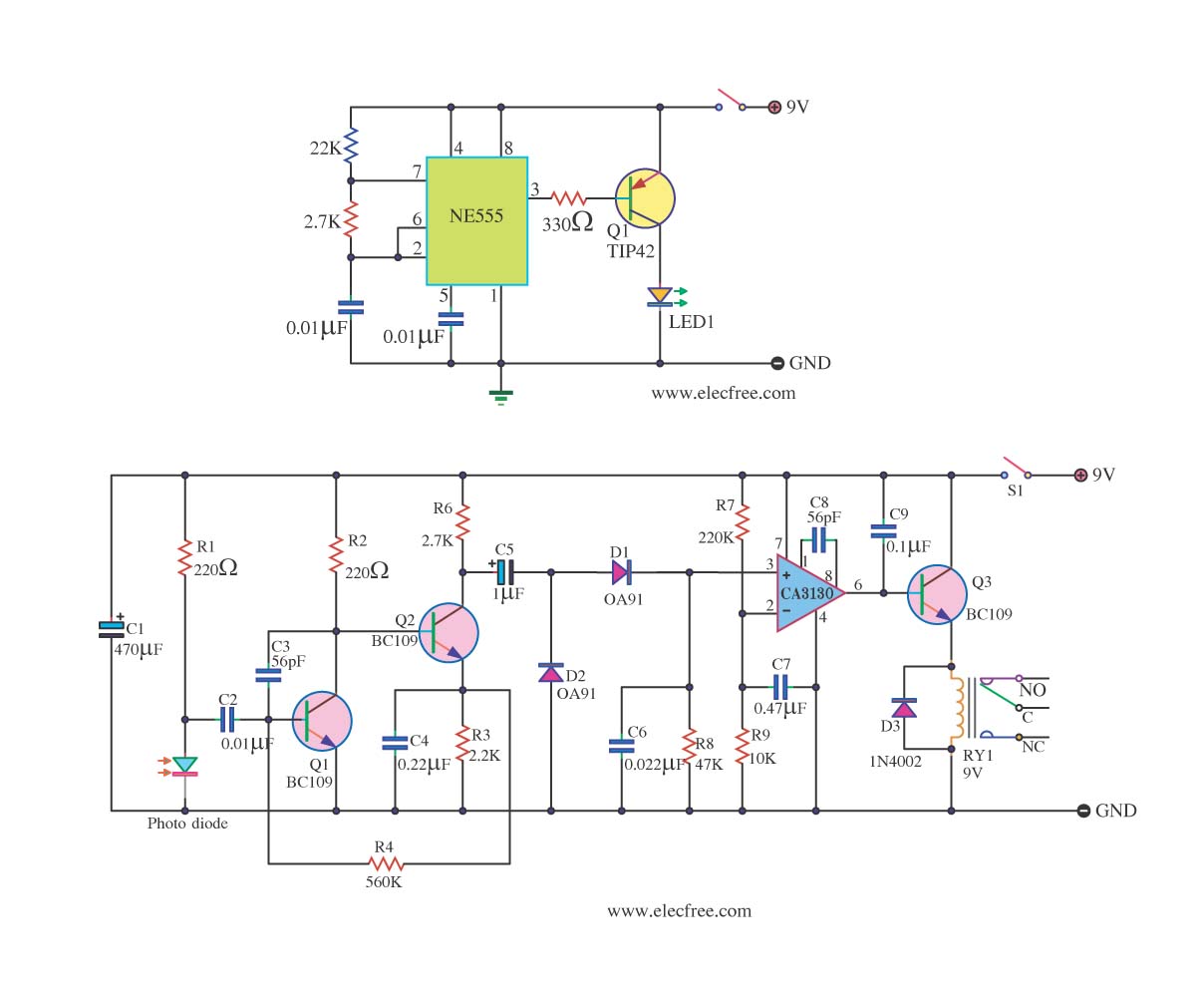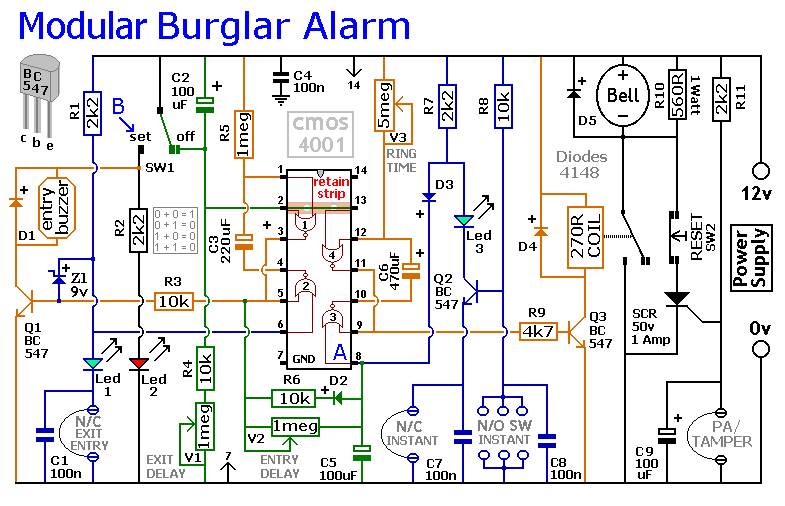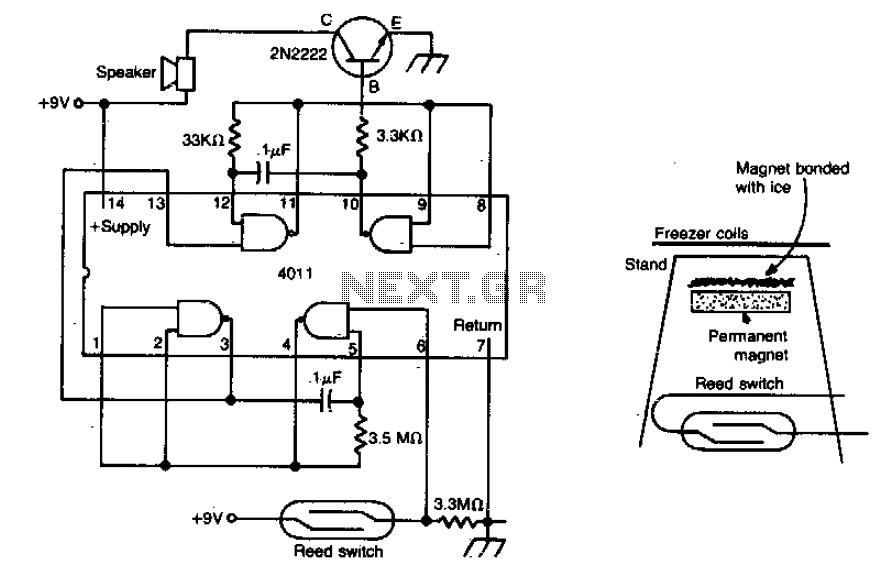
Modular Burglar Alarm
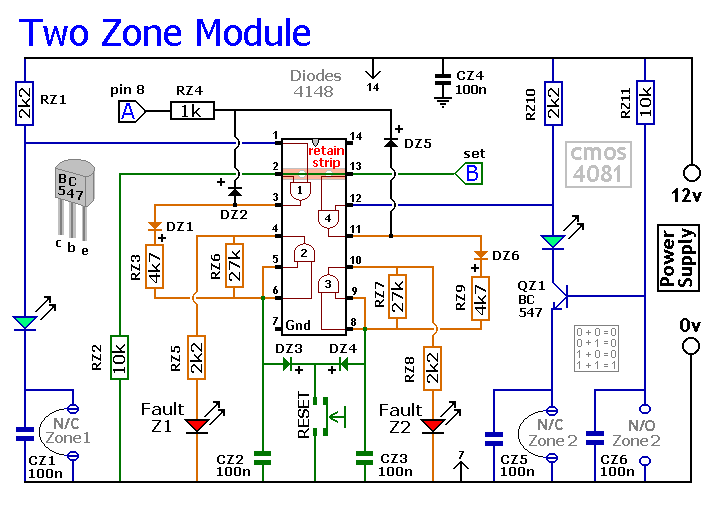
The Basic Alarm Circuit features an automatic Exit/Entry Zone, which includes an Instant Alarm Zone capable of accepting both normally-closed and normally-open triggering devices, alongside an "Always On" 24-hour Personal Attack/Tamper Zone. Expansion Modules can be used to add additional alarm zones as needed. The alarm is armed and disarmed using switch SW1. Before moving the switch to the "set" position, all green LEDs should be illuminated. There is a time allowance of approximately one minute to exit the building. During this time, the Buzzer will sound and will cease once the door is closed, indicating that the Exit/Entry loop has been successfully restored. Upon re-entering, there is also a one-minute window to switch SW1 to the "off" position; failure to do so will energize the relay, causing the main bell to ring for up to 40 minutes, although it can be turned off at any time using SW1. The "Instant" zone has no Entry Delay, meaning that closing one of its normally-open switches or opening one of its normally-closed switches will trigger the main bell immediately. For those who prefer not to use normally-open switches, R8, C8, and Q2 can be omitted, and a link can be fitted between LED 3 and C7. The 24-hour Personal Attack and Tamper protection is managed by a SCR/Thyristor; if a switch in the normally-closed loop is opened, current through R11 will trigger the SCR, activating the main bell without any time limit. To reset the PA/Tamper zone, the normally-closed loop must first be restored, followed by a momentary press of SW2 to interrupt the current and reset the SCR. Support materials for this alarm include a step-by-step guide for constructing the circuit board and expansion modules, parts lists, detailed circuit descriptions, and more. While the basic circuit is adequate for many applications, larger buildings may benefit from a zoned system, which allows for easier fault finding and enables the control panel to identify which zone has been activated. The expansion modules are designed to enhance this capability; although they can work with the existing instant zone, they are intended to replace it. Each triggered zone will illuminate its red LED, indicating activation. After noting the activated zone, pressing the reset button will turn off the LED, but this action does not reset the zone, which will automatically reset once the trigger circuit is restored. Multiple expansion modules can share a single reset button.
The Basic Alarm Circuit is structured to provide reliable security features suitable for various environments. The automatic Exit/Entry Zone is designed to facilitate a seamless user experience, ensuring that all necessary precautions are taken when entering or exiting the premises. The inclusion of both normally-closed and normally-open triggering devices offers flexibility in installation and application, allowing users to tailor the system to their specific security needs.
The design incorporates a straightforward arming and disarming mechanism via switch SW1, which is critical for user interaction. The visual feedback provided by the green LEDs enhances usability by confirming the system's status prior to arming. The Buzzer serves as an audible alert, reinforcing the need for timely exit and re-entry actions.
The Instant Alarm Zone's immediate response to switch activation underscores its importance in high-security scenarios, where any breach must be addressed without delay. The option to omit certain components for users who prefer normally-closed switches further demonstrates the circuit's adaptability.
The 24-hour Personal Attack and Tamper protection feature, managed by the SCR/Thyristor, is a significant enhancement for safeguarding against unauthorized access or tampering. The ability to reset this zone through a simple procedure ensures that the system remains functional and ready for use after an event.
The modularity of the system, facilitated by the Expansion Modules, is particularly advantageous for larger installations. This allows for systematic monitoring and management of multiple zones, enhancing the overall effectiveness of the security system. The design also includes clear indications of zone activation, further aiding in troubleshooting and maintenance.
In conclusion, the Basic Alarm Circuit is a versatile and comprehensive solution for security needs, offering both immediate response capabilities and long-term adaptability through expansion options. The integration of user-friendly features ensures that it can be effectively utilized in various settings, from residential to commercial applications.The Basic Alarm Circuit has an automatic Exit/Entry Zone - an Instant Alarm Zone that will accept both normally-closed and normally-open triggering devices - and an "Always On" 24-hour Personal Attack/Tamper Zone. By using the Expansion Modules - you can add as many extra alarm zones as you require. The Alarm is armed and disarmed by SW1. Before y ou move the switch to the "set" position - all the green LEDs should be lighting. You then have up to about a minute to leave the building. As you do so - the Buzzer will sound. It should stop sounding when you close the door behind you. This indicates that the Exit/Entry loop has been successfully restored within the time allowed. When you re-enter the building - you have up to about a minute to move SW1 to the "off" position. If SW1 is not switched off in time - the relay will energize - and the main bell will ring. It will continue ringing for up to about 40 minutes. But it can be turned off at any time by SW1. The "Instant" zone has no Entry Delay. The moment one of its normally-open switches is closed - the main bell will ring. Similarly - the moment one of its normally-closed switches is opened - the main bell will ring. If you don`t want to use normally-open switches - leave out R8, C8 and Q2 - and fit a link between Led 3 and C7. The 24 Hour Personal Attack and Tamper protection is provided by the SCR/Thyristor. If one of the switches in the normally-closed loop is opened - current through R11 will trigger the SCR - and the main bell will ring.
In this case the bell has no time limit. To reset the PA/Tamper zone - first restore the normally-closed loop - then press SW2 momentarily. This will interrupt the current and reset the SCR. The Support Material for this alarm includes a step-by-step guide to the construction of the circuit-board and the expansion modules - parts lists - detailed circuit descriptions - and more. The basic circuit will be satisfactory in many situations. However, if you have a large building to protect - it`s much easier to find a fault - when the system is divided into zones - and the control panel can "remember" which zone has caused the activation.
The expansion modules are designed to do this. Although they will work with the existing instant zone - they are intended to replace it. When a zone is triggered - its red LED will light and remain lit - to indicate that the zone has been activated. The idea is that - once you`ve noted the zone in question - you then press the reset button and turn off the LED.
The reset button simply turns off the LED. It doesn`t reset the zone. The zone resets automatically when the trigger circuit is restored. If you`re using more than one expansion module - they can all share a single reset button. 🔗 External reference
The Basic Alarm Circuit is structured to provide reliable security features suitable for various environments. The automatic Exit/Entry Zone is designed to facilitate a seamless user experience, ensuring that all necessary precautions are taken when entering or exiting the premises. The inclusion of both normally-closed and normally-open triggering devices offers flexibility in installation and application, allowing users to tailor the system to their specific security needs.
The design incorporates a straightforward arming and disarming mechanism via switch SW1, which is critical for user interaction. The visual feedback provided by the green LEDs enhances usability by confirming the system's status prior to arming. The Buzzer serves as an audible alert, reinforcing the need for timely exit and re-entry actions.
The Instant Alarm Zone's immediate response to switch activation underscores its importance in high-security scenarios, where any breach must be addressed without delay. The option to omit certain components for users who prefer normally-closed switches further demonstrates the circuit's adaptability.
The 24-hour Personal Attack and Tamper protection feature, managed by the SCR/Thyristor, is a significant enhancement for safeguarding against unauthorized access or tampering. The ability to reset this zone through a simple procedure ensures that the system remains functional and ready for use after an event.
The modularity of the system, facilitated by the Expansion Modules, is particularly advantageous for larger installations. This allows for systematic monitoring and management of multiple zones, enhancing the overall effectiveness of the security system. The design also includes clear indications of zone activation, further aiding in troubleshooting and maintenance.
In conclusion, the Basic Alarm Circuit is a versatile and comprehensive solution for security needs, offering both immediate response capabilities and long-term adaptability through expansion options. The integration of user-friendly features ensures that it can be effectively utilized in various settings, from residential to commercial applications.The Basic Alarm Circuit has an automatic Exit/Entry Zone - an Instant Alarm Zone that will accept both normally-closed and normally-open triggering devices - and an "Always On" 24-hour Personal Attack/Tamper Zone. By using the Expansion Modules - you can add as many extra alarm zones as you require. The Alarm is armed and disarmed by SW1. Before y ou move the switch to the "set" position - all the green LEDs should be lighting. You then have up to about a minute to leave the building. As you do so - the Buzzer will sound. It should stop sounding when you close the door behind you. This indicates that the Exit/Entry loop has been successfully restored within the time allowed. When you re-enter the building - you have up to about a minute to move SW1 to the "off" position. If SW1 is not switched off in time - the relay will energize - and the main bell will ring. It will continue ringing for up to about 40 minutes. But it can be turned off at any time by SW1. The "Instant" zone has no Entry Delay. The moment one of its normally-open switches is closed - the main bell will ring. Similarly - the moment one of its normally-closed switches is opened - the main bell will ring. If you don`t want to use normally-open switches - leave out R8, C8 and Q2 - and fit a link between Led 3 and C7. The 24 Hour Personal Attack and Tamper protection is provided by the SCR/Thyristor. If one of the switches in the normally-closed loop is opened - current through R11 will trigger the SCR - and the main bell will ring.
In this case the bell has no time limit. To reset the PA/Tamper zone - first restore the normally-closed loop - then press SW2 momentarily. This will interrupt the current and reset the SCR. The Support Material for this alarm includes a step-by-step guide to the construction of the circuit-board and the expansion modules - parts lists - detailed circuit descriptions - and more. The basic circuit will be satisfactory in many situations. However, if you have a large building to protect - it`s much easier to find a fault - when the system is divided into zones - and the control panel can "remember" which zone has caused the activation.
The expansion modules are designed to do this. Although they will work with the existing instant zone - they are intended to replace it. When a zone is triggered - its red LED will light and remain lit - to indicate that the zone has been activated. The idea is that - once you`ve noted the zone in question - you then press the reset button and turn off the LED.
The reset button simply turns off the LED. It doesn`t reset the zone. The zone resets automatically when the trigger circuit is restored. If you`re using more than one expansion module - they can all share a single reset button. 🔗 External reference
